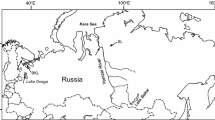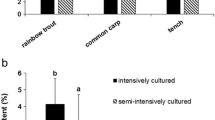Abstract
In this study, the proximate and fatty acid compositions of the muscle tissue of 186 samples of fish belonging to fifteen species of freshwater fish harvested in subalpine lakes (bleak, shad, crucian carp, whitefish, common carp, pike, black bullhead, burbot, perch, Italian roach, roach, rudd, wels catfish, chub and tench) were investigated. Most of the fish demonstrated a lipid content in the fillet lower than 2.0 g 100 g−1 wet weight (range 0.6–9.7). A strong relationship between feeding behavior and fatty acid composition of the muscle lipids was observed. Planktivorous fish showed the lowest amounts of n-3 fatty acids (p < 0.05), but the highest monounsaturated fatty acid (MUFA) contents, in particular 18:1n-9. Conversely, carnivorous fish showed the highest amounts of saturated fatty acids and n-3 fatty acids (p < 0.05), but the lowest MUFA contents. Omnivorous fish showed substantial proportions of n-3 fatty acids and the highest contents of n-6 fatty acids. Principal component analysis showed a distinct separation between fish species according to their feeding habits and demonstrated that the most contributing trophic markers were 18:1n-9, 18:3n-3, 22:6n-3 and 20:4n-6. The quantitative amounts n-3 polyunsaturated fatty acid in muscle tissues varied depending on the fish species, the lipid content and the feeding habits. Some species were very lean, and therefore would be poor choices for human consumption to meet dietary n-3 fatty acid requirements. Nevertheless, the more frequently consumed and appreciated fish, shad and whitefish, had EPA and DHA contents in the range 900–1,000 mg 100 g−1 fresh fillet.

Similar content being viewed by others
Abbreviations
- DHA:
-
Docosahexaenoic acid (22:6n-3)
- EPA:
-
Eicosapentaenoic acid (20:5n-3)
- FAME:
-
Fatty acid methyl esters
- LC-PUFA:
-
Long chain polyunsaturated fatty acid(s)
- MUFA:
-
Monounsaturated fatty acid(s)
- PUFA:
-
Polyunsaturated fatty acid(s)
- SFA:
-
Saturated fatty acid(s)
References
Mitchell M, Vanberg J, Sipponen M (2012) Commercial inland fishing in member countries of the European Inland Fisheries Advisory Commission (EIFAC): operational environments, property rights regimes and socio-economic indicators, FAO, Editor 2012: FAO, Rome p 114
Paleari MA, Soncini G, Beretta G, Grimaldi P, Tava A (1993) Microbiology and chemical composition of a typical product from Alosa fallax lacustris. J Appl Ichthyol 9:222–229
Volta P, Oggioni A, Bettinetti R, Jeppesen E (2011) Assessing lake typologies and indicator fish species for Italian natural lakes using past fish richness and assemblages. Hydrobiologia 671:227–240
Henderson RJ, Tocher DR (1987) The lipid composition and biochemistry of freshwater fish. Prog Lipid Res 26:281–347
Gruger EH, Nelson RW, Stansby ME (1964) Fatty acid composition of oils from 21 species of marine fish, freshwater fish and shellfish. J Am Oil Chem Soc 41:662–667
Kinsella JE, Shimp JL, Mai J, Weihrauch J (1977) Fatty acid content and composition of freshwater finfish. J Am Oil Chem Soc 54:424–429
Ackman RG (1967) Characteristics of the fatty acid composition and biochemistry of some fresh-water fish oils and lipids in comparison with marine oils and lipids. Comp Biochem Physiol 22:907–922
Li G, Sinclair AJ, Li D (2011) Comparison of lipid content and fatty acid composition in the edible meat of wild and cultured freshwater and marine fish and shrimps from China. J Agric Food Chem 59:1871–1881
Grahl-Nielsen O, Averina E, Pronin N, Radnaeva L, Kakela R (2011) Fatty acid profiles in different fish species in Lake Baikal. Aquat Biol 13:1–10
Özogul Y, Özogul F, Alagoz S (2007) Fatty acid profiles and fat contents of commercially important seawater and freshwater fish species of Turkey: a comparative study. Food Chem 103:217–223
Rahnan SA, Huah TS, Nassan O, Daud NM (1995) Fatty acid composition of some Malaysian freshwater fish. Food Chem 54:45–49
Ackman RG (1989) Nutritional composition of fats in seafoods. Prog Food Nutr Sci 13:161–289
Halver JE, Hardy RW (2002) Fish nutrition. Academic Press, San Diego, Califonia
Luzzana U, Serrini G, Moretti VM, Grimaldi P, Paleari MA, Valfre F (1996) Seasonal variations in fat content and fatty acid composition of male and female coregonid ‘bondella’ from Lake Maggiore and landlocked shad from Lake Como (northern Italy). J Fish Biol 48:352–366
Orban E, Nevigato T, Masci M, Di Lena G, Casini I, Caproni R, Gambelli L, De Angelis P, Rampacci M (2007) Nutritional quality and safety of European perch (Perca fluviatilis) from three lakes of Central Italy. Food Chem 100:482–490
Orban E, Masci M, Nevigato T, Di Lena G, Casini I, Caproni R, Gambelli L, De Angelis P, Rampacci M (2006) Nutritional quality and safety of whitefish (Coregonus lavaretus) from Italian lakes. J Food Compos Anal 19:737–746
Serrini G, Luzzana U, Grimaldi P, Paleari MA, Valfre F (1996) Fatty acid composition of some coregonid species (Coregonus spp.) from different European lakes. J Appl Ichthyol 12:57–59
Tartari G (2005) Qualità delle acque lacustri in Lombardia. 1° Rapporto OLL 2004. Fondazione Lombardia per l’ambiente Milano
European C (2000) Directive 2000/60/EC of the European Parliament and of the Council of 23 October 2000 establishing a framework for Community action in the field of water policy. Off J Eur Communities L 327:1–72
AOAC. (1996) Official methods of analysis of the Association of official analytical chemists. Association of official analytical chemists, Arlington (USA)
Folch J, Lees M, Sloane Stanley GH (1957) A simple method for the isolation and purification of total lipids from animal tissues. J Biol Chem 226:497–509
Christie WW (2003) Preparation of derivatives of fatty acid. In: Christie WW (ed) Lipid analysis isolation, separation, identification and structural analysis of lipids. The Oily Press, Bridgwater
Ackman RG (2002) The gas chromatograph in practical analyses of common and uncommon fatty acids for the 21st century. Anal Chim Acta 465:175–192
Salmaso N, Morabito G, Buzzi F, Garibaldi L, Simona M, Mosello R (2006) Phytoplankton as an indicator of the water quality of the deep lakes south of the Alps. Hydrobiologia 563:167–187
Premazzi G, Dalmiglio A, Cardoso AC, Chiaudani G (2003) Lake management in Italy: the implications of the Water Framework Directive. Lakes & Reserv: Res & Manage 8:41–59
Bianco PG (1995) Mediterranean endemic freshwater fishes of Italy. Biol Conserv 72:159–170
Froese R, and Pauly D, Fishbase, 2014, Fishbase
Zhou L, Wang YF, Gui JF, and Gui JF (2000) Genetic evidence for gonochoristic reproduction in gynogenetic silver crucian carp (Carassius auratus gibelio bloch) as revealed by RAPD assays
James Henderson R, Tocher DR (1987) The lipid composition and biochemistry of freshwater fish. Prog Lipid Res 26:281–347
Arts MT, and Wainman BV (1999) Lipids in Freshwater Ecosystems 303
Huss HH (1988) Fresh fish quality and quality changes. FAO Fisheries Ser 29:132
Rahman SA, Teh Sing H, Hassan O, Daud NM (1995) Fatty acid composition of some Malaysian freshwater fish. Food Chem 54:45–49
Guler GO, Kiztanir B, Aktumsek A, Citil OB, Ozparlak H (2008) Determination of the seasonal changes on total fatty acid composition and omega3/omega6 ratios of carp (Cyprinus carpio L.) muscle lipids in Beysehir Lake (Turkey). Food Chem 108:689–694
Celik M, Diler A, Kucukgulmez A (2005) A comparison of the proximate compositions and fatty acid profiles of zander (Sander lucioperca) from two different regions and climatic conditions. Food Chem 92:637–641
Desvilettes CH, Bourdier G, Amblard CH, Barth B (1997) Use of fatty acids for the assessment of zooplankton grazing on bacteria, protozoans and microalgae. Freshw Biol 38:629–637
Ratledge C (1997) Microbial Lipids. Biotechnology. Wiley-VCH Verlag GmbH
Ahlgren G, Lundstedt L, Brett M, Forsberg C (1990) Lipid composition and food quality of some freshwater phytoplankton for cladoceran zooplankters. J Plankton Res 12:809–818
Berg A, and Grimaldi E (1996) Study on the biology of the fish in the Lago Maggiore with the aim of collecting data as a basis for forecasting the possible interactions between these fish and the radioactivity present in the water. Biology of the fish of Lago Maggiore: II. Genus alosa III. Census of the commercial fish catches. Brussels. p 34
Berg A, and Grimaldi E (1966) Ecological relationships between planktophagic fish species in the Lago Maggiore. Verh Int Ver Limnol 1065–1073
Linko RR, Rajasilta M, Hiltunen R (1992) Comparison of lipid and fatty acid composition in vendace (Coregonus albula L.) and available plankton feed. Comp Biochem Physiol Part A: Physiol 103:205–212
Wirth M, Steffens W (1998) Seasonal changes in lipid content and fatty acid composition of vendace (Coregonus albula) and its plankton food. Arch Hydrobiol Spec Issues Adv Limnol 50:143–150
Lal B, Singh TP (1987) Changes in tissue lipid levels in the freshwater catfish Clarias batrachus associated with the reproductive cycle. Fish Physiol Biochem 3:191–201
Ackman RG, Takeuchi T (1986) Comparison of fatty acids and lipids of smolting hatchery-fed and wild Atlantic salmon Salmo salar. Lipids 21:117–120
Ahlgren G, Gustafsson I-B, Boberg M (1992) Fatty acid content and chemical composition of freshwater microalgae. J Phycol 28:37–50
Caramujo M-J, Boschker HTS, Admiraal WIM (2008) Fatty acid profiles of algae mark the development and composition of harpacticoid copepods. Freshw Biol 53:77–90
Ghioni C, Bell JG, Sargent JR (1996) Polyunsaturated fatty acids in neutral lipids and phospholipids of some freshwater insects. Comp Biochem Physiol—Part B: Biochem Mol Biol 114:161–170
T S, S U, P E, AWE G, O A, MT B (2013) Fatty acid composition as biomarkers of freshwater microalgae: analysis of 37 strains of microalgae in 22 genera and in seven classes. Aquat Microb Ecol 71:165–178
Napolitano GE (1999) Fatty acids as trophic and chemical markers in freshwater ecosystems. In: Wainman B, Arts M (eds) Lipids in freshwater ecosystems. Springer, New York
Cavaletto J, Gardner W (1999) Seasonal dynamics of lipids in freshwater benthic invertebrates. In: Wainman B, Arts M (eds) Lipids in freshwater ecosystems. Springer, New York
Küçükgülmez A, Eslem Kadak A, Celik M (2010) Fatty acid composition and sensory properties of wels catfish (Silurus glanis) hot smoked with different sawdust materials. Int J Food Sci Technol 45:2645–2649
Jankowska B, Zakes Z, Zmijewsky T, Ulikowski D, Kowalska A (2004) Impact of diet on the fatty acid profile of European catfish (Silurus glanis L.). Archices of Polish Fisheries 12:99–110
Binner M, Kloas W, Hardewig I (2008) Energy allocation in juvenile roach and burbot under different temperature and feeding regimes. Fish Physiol Biochem 34:103–116
Goedkoop W, Sonesten L, Ahlgren G, Boberg M (2000) Fatty acids in profundal benthic invertebrates and their major food resources in Lake Erken, Sweden: seasonal variation and trophic indications. Can J Fish Aquat Sci 57:2267–2279
Simopoulos AP (2002) The importance of the ratio of omega-6/omega-3 essential fatty acids. Biomed Pharmacother 56:365–379
Leaf A, Weber PC (1987) A new era for science in nutrition. Am J Clin Nutr 45:1048–1053
Steffens W, Wirth M (2007) Influence of nutrition on the lipid quality of pond fish: common carp (Cyprinus carpio) and tench (Tinca tinca). Aquac Int 15:313–319
Flock MR, Harris Ws F, Kris-Etherton PM, and Kris-Etherton PM) Long-chain omega-3 fatty acids: time to establish a dietary reference intake
Binelli A, Provini A (2003) The PCB pollution of Lake Iseo (N. Italy) and the role of biomagnification in the pelagic food web. Chemosphere 53:143–151
Binelli A, Galassi S, Provini A (2001) Factors affecting the use of Dreissena polymorpha as a bioindicator: the PCB pollution in Lake Como (N. Italy). Water Air Soil Pollut 125:19–32
Acknowledgments
This research was financially supported by the “Cross-border cooperation operational programme: Italy-Switzerland 2007–2013” from the European Commission, under the European Territorial Cooperation objective in Italy and Switzerland.
Conflict of interest
The authors declare that there are no conflicts of interest.
Author information
Authors and Affiliations
Corresponding author
Additional information
Dedication
This work is dedicated to the memory of Prof. Maria Antonietta Paleari, a rare woman, an outstanding scientist and a precious friend, who passed away on 20th December 2013.
About this article
Cite this article
Vasconi, M., Caprino, F., Bellagamba, F. et al. Fatty Acid Composition of Freshwater Wild Fish in Subalpine Lakes: A Comparative Study. Lipids 50, 283–302 (2015). https://doi.org/10.1007/s11745-014-3978-4
Received:
Accepted:
Published:
Issue Date:
DOI: https://doi.org/10.1007/s11745-014-3978-4




